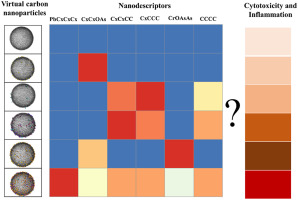当前位置:
X-MOL 学术
›
Ecotox. Environ. Saf.
›
论文详情
Our official English website, www.x-mol.net, welcomes your feedback! (Note: you will need to create a separate account there.)
Analysis of model PM2.5-induced inflammation and cytotoxicity by the combination of a virtual carbon nanoparticle library and computational modeling.
Ecotoxicology and Environmental Safety ( IF 6.8 ) Pub Date : 2020-01-20 , DOI: 10.1016/j.ecoenv.2020.110216 Guohong Liu 1 , Xiliang Yan 2 , Alexander Sedykh 3 , Xiujiao Pan 1 , Xiaoli Zhao 4 , Bing Yan 5 , Hao Zhu 6
Ecotoxicology and Environmental Safety ( IF 6.8 ) Pub Date : 2020-01-20 , DOI: 10.1016/j.ecoenv.2020.110216 Guohong Liu 1 , Xiliang Yan 2 , Alexander Sedykh 3 , Xiujiao Pan 1 , Xiaoli Zhao 4 , Bing Yan 5 , Hao Zhu 6
Affiliation

|
Health risks induced by PM2.5 have become one of the major concerns among living populations, especially in regions facing serious pollution such as China and India. Furthermore, the composition of PM2.5 is complex and it also varies with time and locations. To facilitate our understanding of PM2.5-induced toxicity, a predictive modeling framework was developed in the present study. The core of this study was 1) to construct a virtual carbon nanoparticle library based on the experimental data to simulate the PM2.5 structures; 2) to quantify the nanoparticle structures by novel nanodescriptors; and 3) to perform computational modeling for critical toxicity endpoints. The virtual carbon nanoparticle library was developed to represent the nanostructures of 20 carbon nanoparticles, which were synthesized to simulate PM2.5 structures and tested for potential health risks. Based on the calculated nanodescriptors from virtual carbon nanoparticles, quantitative nanostructure-activity relationship (QNAR) models were developed to predict cytotoxicity and four different inflammatory responses induced by model PM2.5. The high predictability (R2 > 0.65 for leave-one-out validations) of the resulted consensus models indicated that this approach could be a universal tool to predict and analyze the potential toxicity of model PM2.5, ultimately understanding and evaluating the ambient PM2.5-induced toxicity.
更新日期:2020-01-21



























 京公网安备 11010802027423号
京公网安备 11010802027423号